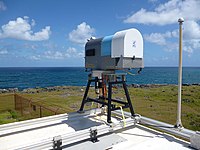
Photo from wikipedia
The ground-based microwave radiometer (MWR) retrieves atmospheric profiles with a high temporal resolution for temperature and humidity up to a height of 10 km. Such profiles are critical for understanding… Click to show full abstract
The ground-based microwave radiometer (MWR) retrieves atmospheric profiles with a high temporal resolution for temperature and humidity up to a height of 10 km. Such profiles are critical for understanding the evolution of climate systems. To improve the accuracy of profile retrieval in MWR, we developed a deep learning approach called batch normalization and robust neural network (BRNN). In contrast to the traditional backpropagation neural network (BPNN), which has previously been applied for MWR profile retrieval, BRNN reduces overfitting and has a greater capacity to describe nonlinear relationships between MWR measurements and atmospheric structure information. Validation of BRNN with the radiosonde demonstrates a good retrieval capability, showing a root-mean-square error of 1.70 K for temperature, 11.72% for relative humidity (RH), and 0.256 g/m3 for water vapor density. A detailed comparison with various inversion methods (BPNN, extreme gradient boosting, support vector machine, ridge regression, and random forest) has also been conducted in this research, using the same training and test data sets. From the comparison, we demonstrated that BRNN significantly improves retrieval accuracy, particularly for the retrieval of temperature and RH near the surface.
Journal Title: IEEE Transactions on Geoscience and Remote Sensing
Year Published: 2020
Link to full text (if available)
Share on Social Media: Sign Up to like & get
recommendations!